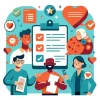
Outpatient Feedback Template: Gathering Essential Insights
In today’s healthcare environment, understanding patient experiences is crucial for maintaining and improving care quality. An outpatient feedback template serves as an essential tool for gathering patient insights.
These templates are designed to capture meaningful feedback from outpatients, which helps healthcare providers identify areas of excellence and those needing improvement.
Importance of Outpatient Feedback
Feedback from outpatients provides a window into the effectiveness of healthcare services from the patient’s perspective. When utilized effectively, an outpatient feedback template can help healthcare providers make informed decisions that improve care quality.
Patients, especially those in outpatient settings, experience care differently than those in inpatient facilities. Therefore, understanding their unique experiences is essential for continuous improvement in healthcare delivery.
Top Outpatient Feedback Template Examples
Example.1

Example.2

Components of an Effective Outpatient Feedback Template
To effectively gather patient insights, an outpatient feedback template must include specific components. These elements are designed to extract detailed and actionable feedback from patients. The following sections delve into the critical components of an effective feedback template.
1. Patient Information Section
This section collects basic patient details such as name, age, gender, and contact information. While this might seem straightforward, it’s important to ensure confidentiality and comply with data protection regulations.
Collecting demographic data can help in analyzing trends and tailoring services to different patient groups.
2. Visit Details
Capturing information about the visit, such as the date, department, and healthcare provider involved, helps contextualize the feedback. This allows for more targeted analysis and improvement efforts.
For example, if multiple patients report dissatisfaction with a specific department, this data can help in identifying and addressing the root cause.
3. Likert Scale Questions
Likert scale questions are commonly used in feedback forms because they allow patients to express their level of agreement or satisfaction on a scale.
For example, a question might ask, How satisfied were you with the quality of care provided? with response options ranging from Very Satisfied to Very Dissatisfied.
These questions provide quantifiable data that can be easily analyzed and compared over time.
4. Open-Ended Questions
While Likert scale questions offer quantifiable data, open-ended questions allow patients to provide more detailed and nuanced feedback.
Questions like What did you like most about your visit? or How can we improve our services? give patients the freedom to express their thoughts in their own words.
This qualitative data can uncover issues or insights that might not be evident from closed-ended questions alone.
5. Service-Specific Queries
Different services within an outpatient setting may require specific feedback. For instance, feedback for a radiology department might focus on the clarity of instructions and waiting time.
While feedback for a consultation might focus on communication and the adequacy of explanations provided. Including service-specific queries ensures that feedback is relevant and actionable.
6. Overall Experience Rating
A section dedicated to rating the overall experience allows patients to provide a summary assessment of their visit. This rating is often a good indicator of patient satisfaction and can be used as a benchmark for tracking improvements over time.
7. Additional Comments
An additional comments section allows patients to share any feedback that wasn’t captured by the other questions. This open-ended section can provide unexpected insights and is a crucial part of a comprehensive outpatient feedback template.
Best Practices for Designing an Outpatient Feedback Template
Creating an effective outpatient feedback template requires attention to detail and a focus on patient needs. The following best practices can help in designing a feedback template that is both effective and user-friendly.
1. Keep it Simple and Concise
Patients are more likely to complete a feedback form that is straightforward to understand. Avoid jargon and keep questions concise. The goal is to gather essential insights without overwhelming the patient.
2. Ensure Anonymity and Confidentiality
To encourage honest feedback, it’s important to reassure patients that their responses will remain anonymous and confidential. This can be done by including a statement at the beginning of the form that explains how the data will be used and protected.
3. Use a Mix of Question Types
Combining different question types—such as the Likert scale, multiple-choice, and open-ended questions—can provide a more comprehensive understanding of patient experiences. Each question type has its strengths, and using a mix ensures that you capture both quantitative and qualitative data.
4. Test the Template
Before rolling out the feedback template to all patients, conduct a pilot test with a small group. This allows you to identify any issues or ambiguities in the questions and make necessary adjustments.
5. Regularly Update the Template
Healthcare services evolve, and so should your feedback template. Regularly review and update the questions to ensure they remain relevant and aligned with current healthcare goals and patient needs.
Implementing the Outpatient Feedback Template in Your Healthcare Facility
Successfully implementing an outpatient feedback template involves more than just distributing forms. It requires a systematic approach to collecting, analyzing, and acting on the feedback received.
1. Distribution Methods
There are several ways to distribute the feedback template to outpatients. These include:
- Paper Forms: Traditional but still effective, especially for older patients or those less comfortable with technology.
- Digital Forms: These can be sent via email or accessed through a patient portal. They are convenient and allow for easier data analysis.
- On-site Tablets: Placing tablets in waiting areas allows patients to complete the form before they leave the facility.
2. Encouraging Patient Participation
To gather meaningful insights, it’s essential to encourage patients to participate in the feedback process. This can be done by:
- Explaining the Importance: Making it clear to patients how their feedback contributes to improving care quality.
- Offering Incentives: Consider small incentives, like a discount on future services, to encourage participation.
- Following Up: Send reminders to patients who haven’t completed the feedback form, emphasizing the value of their input.
3. Analyzing the Data
Once feedback is collected, it needs to be analyzed in a way that identifies trends and areas for improvement. Consider using software tools that can handle both quantitative and qualitative data.
Look for patterns in the responses, such as recurring complaints or frequent mentions of a particularly positive aspect of care.
4. Acting on Feedback
The ultimate goal of gathering feedback is to make improvements. Share the insights gained from the feedback with relevant departments and create action plans to address any identified issues. For instance, if patients frequently mention long waiting times, consider reviewing scheduling practices or staffing levels.
5. Communicating Changes to Patients
Patients will appreciate knowing that their feedback has been taken seriously and acted upon. Communicate any changes made as a result of their feedback, either through newsletters, the patient portal, or during their next visit.
Challenges in Gathering Outpatient Feedback and How to Overcome Them
While the benefits of gathering outpatient feedback are clear, there are also challenges that healthcare providers may face in this process. Understanding these challenges and knowing how to overcome them is crucial for success.
1. Low Response Rates
One of the most common challenges is achieving a high response rate. Many patients may be reluctant to fill out feedback forms, either because they feel it’s time-consuming or because they don’t believe their feedback will make a difference.
Overcoming This Challenge:
To overcome low response rates, healthcare providers can streamline the feedback process, making it as quick and easy as possible. Additionally, emphasizing the impact of patient feedback on improving care quality can motivate more patients to participate.
2. Biased Responses
Patients who had either a very positive or very negative experience may be more likely to provide feedback, leading to skewed results.
Overcoming This Challenge:
To mitigate this bias, it’s important to encourage all patients to provide feedback, regardless of their experience. Offering a small incentive for completing the form can also help increase participation across a broader spectrum of patients.
3. Data Overload
Collecting large amounts of feedback can be overwhelming, especially if the data is not organized or analyzed properly.
Overcoming This Challenge:
Using data analysis tools can help manage and interpret large volumes of feedback. It’s also important to focus on the most critical insights that can lead to actionable improvements.
Conclusion
Gathering essential insights through an outpatient feedback template is a critical step toward improving patient care and satisfaction. By designing a well-structured template that captures both quantitative and qualitative data, healthcare providers can gain a deeper understanding of patient experiences.
Implementing the feedback process effectively, analyzing the data, and taking action based on the insights gathered can lead to tangible improvements in healthcare services. In an industry where patient satisfaction is paramount, the role of an outpatient feedback template cannot be overstated.
Frequently Asked Questions?
What is An Outpatient Feedback Template?
An outpatient feedback template is a structured form used by healthcare providers to collect feedback from patients who receive care without being admitted to a hospital. This template helps gather insights on patient satisfaction, care quality, and areas needing improvement.
Why is Outpatient Feedback Important?
Outpatient feedback is crucial because it provides healthcare providers with direct insights into patient experiences. This feedback helps identify strengths and weaknesses in the care process, enabling targeted improvements that enhance patient satisfaction and care outcomes.
What Should Be Included in An Outpatient Feedback Template?
An effective outpatient feedback template should include patient information, visit details, Likert scale questions, open-ended questions, service-specific queries, an overall experience rating, and an additional comments section.
How Can I Increase Patient Participation in Feedback Surveys?
To increase patient participation, make the feedback process simple and convenient, offer small incentives, and emphasize the importance of their feedback in improving care quality. Following up with patients who haven’t completed the survey can also help.
Enhance Patient Care and NABH Compliance with LazyMonkey
LazyMonkey is your all-in-one solution for improving patient care, retaining more patients, and meeting NABH standards. Our powerful QR-based feedback tool enables you to capture real-time insights from patient feedback, discharge surveys, staff and doctor evaluations, and clinical research, while also streamlining inter-departmental communication.
Transform your healthcare facility today - reach out to us at hello@lazymonkey.in, or request a demo here!
Elevate Your Restaurant Experience with LazyMonkey
LazyMonkey’s QR-based feedback system helps you gather real-time insights from customers, track satisfaction levels, and enhance the dining experience. Get instant feedback on your menu, service, and ambience, and make data-driven improvements to boost repeat customers and reviews.
Improve your restaurant today – reach out to us at hello@lazymonkey.in, or request a demo here!
Empower Student Engagement and Campus Improvement with LazyMonkey
LazyMonkey offers a seamless way to gather student feedback, track satisfaction, and enhance campus life. From course evaluations to dorm feedback, our QR-based solution makes it easy to capture valuable insights and improve student retention.
Upgrade your university experience – contact us at hello@lazymonkey.in, or request a demo here!
Streamline Feedback and Drive Performance Across Your Enterprise/Franchise with LazyMonkey
Whether you manage one or multiple locations, LazyMonkey’s QR-based feedback system helps you gather real-time employee and customer feedback. Improve operational efficiency, track satisfaction, and make data-driven decisions to enhance brand consistency and growth.
Transform your franchise today – reach out to us at hello@lazymonkey.in, or request a demo here!
Enhance Customer Satisfaction and Service Standards in Banking with LazyMonkey
LazyMonkey empowers banks to capture real-time feedback from clients across branches. Improve customer experience, assess service quality, and ensure regulatory compliance with our QR-based solution, helping you retain clients and meet banking standards.
Elevate your bank’s customer care – contact us at hello@lazymonkey.in, or request a demo here!
Boost Customer Engagement and Mall Satisfaction with LazyMonkey
LazyMonkey’s QR-based feedback tool enables you to collect feedback from shoppers, track satisfaction, and enhance the mall experience. Gather insights on store services, cleanliness, and entertainment to create an unmatched customer journey.










